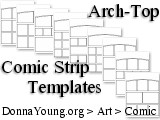Spacing Vertical or Horizontal Elements
DML is short for Diagonal Measuring Line. Note: terms use on this page may not be universal.
 This picture is an example of how to space vertical objects such as posts, poles. Study the picture to figure out how it is done. This also applies to horizontal elements that are evenly spaced.
This picture is an example of how to space vertical objects such as posts, poles. Study the picture to figure out how it is done. This also applies to horizontal elements that are evenly spaced.
 This is based on this one simple fact.
This is based on this one simple fact.
An X drawn corner to corner inside a square, rectangle, or circle will show you where the center is and this will allow you to draw things that are regularly spaced such as tiles in floors, railroad tracks, and telephone poles, and so forth.

Consider this idea with a grid.
This image shows a model of squares with a diagonal line drawn through the corners. Take note of what we normally take for granted... the diagonal line crosses through the intersections of the squares.
Look at the foreshortened model of the squares. Notice that the diagonal measuring line (DML) crosses through the intersections in the same way.

Consider how understanding this simple fact this will help you draw in perspective. For instance, the drawing below is possible with the diagonal measuring line.
Go to: 1-Point Grid for steps in drawing a gridded plane with one-point perspective


The grid on the ground line (GL) or horizontal measuring line (HML) determines the spacing of the parallel lines that meet at the vanishing point. (The lines going toward the vanishing point are parallel.. They don't look parallel do they? In real life they would be.)
 The DML determines where the horizontal lines will be drawn. Notice in the image where the BLUE DML intersects with the parallel lines (circled in yellow in the image to the left.) The intersection of the DML with the parallel lines is where to draw the horizontal lines. (Remember the grid?)
The DML determines where the horizontal lines will be drawn. Notice in the image where the BLUE DML intersects with the parallel lines (circled in yellow in the image to the left.) The intersection of the DML with the parallel lines is where to draw the horizontal lines. (Remember the grid?)
Now it is just a matter of precise drawing.
2-Point Perspective Models
I'm sorry that I do not have time to write about these drawings. I'm going to drop them here and perhaps just observing where the SVP are in relation to the location of other points will be self-explanatory on the effects of the gridded plane.








Circles

The DML (diagonal measuring line) will help you make circles too. Look at the image above. I have drawn a square and then I marked the square with two DML's making an x in the square. Next each DML half was divided into thirds.. that is what the tick-marks are on the lines. Next a circle was drawn using the tick marks and the square's 4 sides. Notice one thing... The circle is just beyond the tick marks; it is not on the tick mark.
Now take this idea into a cube. See image below Carefully look at the tick marks in this foreshortened cube. Note that the tick marks furthest away are closer to the circle. Always keep in mind that you are drawing in perspective and the parts of the drawing which are "further away" become closer to each other and smaller and thinner.
Carefully look at the tick marks in this foreshortened cube. Note that the tick marks furthest away are closer to the circle. Always keep in mind that you are drawing in perspective and the parts of the drawing which are "further away" become closer to each other and smaller and thinner.
It takes some practice to be able to do this well, so don't give up if it seems difficult.

Artist of interest:
Online link:
M.
C. Escher


 This is an undated "dated" blank monthly calendar.
This is an undated "dated" blank monthly calendar. The 1/2 rule height version of this set "DN" is finished.
The 1/2 rule height version of this set "DN" is finished.


